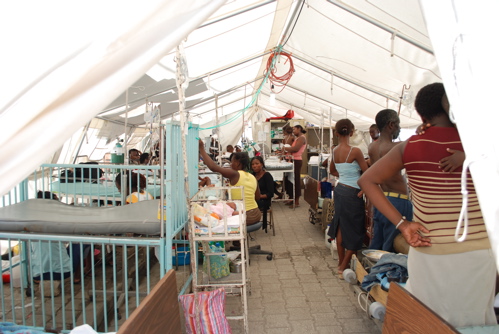 One of two Pediatric tents we visited
One of two Pediatric tents we visited
There is a sign in a damaged Petionville, Haiti bar that reads: "There are no truths, there are only stories." Let's begin by telling a story that may or may not reveal some truths about the stranglehold foreign aid has on Haiti's health care delivery system.
During our second trip to Haiti since the earthquake, we were on the premises of a hospital in Port-au-Prince called Hopital De L'Universite D'Etat D'Haiti (HUEH) when the rhythmical sound of women praying drew us to the perimeter of a sweltering tent where temperatures soared well into the 90-degree range. As the African writer Beryl Markham (West With the Night) suggested, it is "difficult to bring order out of memory. So, days later, the writer relied on notes, photos stored on the big Nikon, and video taken on a pocket Sony camera in order to revisit the tent. Surprisingly, a short, grainy video clip revealed the image of a critically ill infant waving a withered arm.
The waving arm was a surprise and the writer thought, "How wonderful that the infant waved at me," taking the gesture as proof that the suffering infant "needed" help that the American could offer in the way of a story. But this was not the truth of the matter.
When it came time to do an edit of the video, something else surfaced. There was a fly crawling across the face of the infant, circling the tube that ran into the baby's body through his nose. The congenitally deformed arm was trying to dislodge the fly. The baby was not "waving" at anyone, and it is doubtful that the strong, suffering baby with charts and papers piled in his crib "saw" anyone. The baby was a survivor, still struggling to defend himself from a fly, an invader willing to feed on his suffering.
The infant with the withered arm is Haiti. She is struggling in all of her suffering to wave the flies of foreign interference, hubris, and foreign aid feeders away from her face. For all of the "attention" and "aid" offered to Haiti, she has been abandoned as surely as the infant with the damaged arm.
"Why" the infant lies all but abandoned in a sweltering tent is partially the result of the January 12 earthquake, and partially the result of misplaced foreign aid, good intentions gone awry, as well as international greed, arrogance and incompetence.
Dr. Louis-Franck Telemaque is the Chief of Surgery at HUEH. An intense man, Telemaque speaks in terms of the hospital "before the quake" and "after the quake." He scrutinizes you as you take notes, and if the writer's eyes wander to gauge his demeanor, he demands to know if you are paying attention and writing down the bullet items, "one through five" that he presented. Telemaque has a message and he wants it heard.

Dr. Louis-Franck Telemaque, Chief of Surgery, in what remains of his office at Hopital De L'Universite D'Etat D'Haiti
We met with Telemaque after HUEH director, Dr. Alix Lassegue, gave us free reign on a tour of the hospital grounds and damaged buildings. What we saw would be intolerable conditions in the first world and reminded us of what we had seen in Congo, but worse. The emergency room had no surgical lights, transom windows providing minimal illumination. Only two sterile operating tables were functioning, since the original suite was heavily damaged in the earthquake. There is not enough film for radiography, no stretcher wipes, no surgical sterile wipes, no equipment wipes, no sheets and no way to wash them if they were available. Ultra sound gel is needed, as are towels, since there is no way to clean up blood and fluids after a trauma case passes through the emergency room.
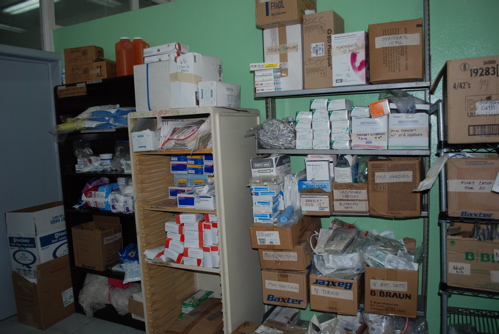
Trauma "supplies"
The school of nursing is in complete ruins, and over one hundred students and teachers perished there. The diagnostic laboratory is housed in a tent donated by UNICEF. The lab has some equipment; much of it outdated donations from the CDC.
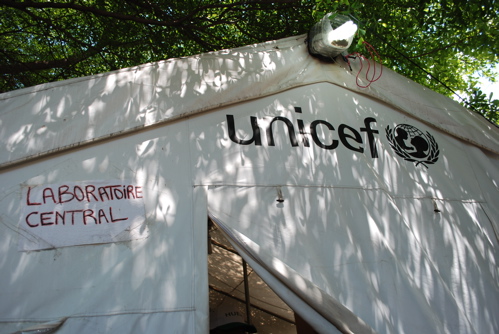
Laboratory Facilities
The pediatrics building was destroyed and this partially explains the tents with the praying women. There is simply no other facility to house critically ill babies and children. In a twist of fate, the OBGYN building survived, so children may enter this world under watchful eyes and good care, but if they fall ill the critical care facilities are far beyond what anyone in the United States would find "acceptable."
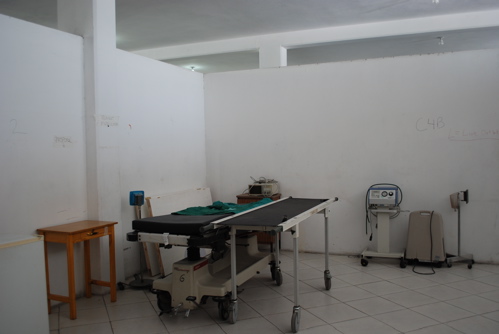
Non-sterile surgical suite
The earthquake destroyed the Offices of the Health Ministry, and as a result employment records for hospital staff were lost in the rubble. Doctors and nurses have not paid for 8 months, with the exception of 150 who are part of 800 individuals under contract. There are 1800 total health care workers in the HUEH system.
A volunteer American Emergency Room doctor, Sonia Winslett, working with an international medical NGO, told us she felt guilty when she realized her airfare and per diem costs for meals would pay the salary of a Haitian surgical resident for up to five months.
Possibly enhanced by the devastation of the January earthquake, house staff have not been paid for months. As a result, some (Haitian) staff have continued to perform work and some have not. For example there was no OB/GYN service and deliveries were performed by volunteer medical teams in the emergency room (ER) or, if stable, near term women were transported to another hospital with OB personnel. Volunteer medical staff also provided a significant amount of pediatric care. Volunteer medical personnel mostly staffed the ER and ICU with some scattered presence by the Haitian house staff of physicians, nurses and maintenance. In one instance, the Miami Hospital team came to HUEH to perform a craniotomy yet opted to perform the surgery in the ER because the OR (operating room) at HUEH was determined to be too dirty.
Most private hospitals were either destroyed or closed after the earthquake, and so the burden to treat a population of 500,000 has fallen on HUEH, which was the equivalent of a county hospital here in the States before the disaster, providing health care to anyone, regardless of financial ability. Like the fictional ER on American television, HUEH is a teaching hospital and depends upon rotating medical students from a nearby university.
Dr. Telemaque explained conditions before the quake.
Prior to the earthquake, HUEH had an indoor emergency room, but no ICU. The patient load included mainly HIV, tuberculosis and malaria cases. Because Haiti received a lot of international aid before the quake, the hospital was limited in service and international aid stopped at our doors. We were a public hospital and not considered a priority.
Then the earthquake happened, and much of the medical infrastructure in Port-au-Prince was destroyed. This put the trauma burden on HUEH. "Sanitation was poor before the quake and now it is more important than ever," Telemaque said. "We are not doing quality surgery now and we were not doing quality surgery before the quake."
Why? "Because all of the aid is in the wrong place." We had heard this refrain in all areas of the earthquake zone when we questioned why conditions had not improved with the huge influx of NGOs and dollars. The USAID website reports that the U.S. Department of Health and Human Services has given $36,196,000 to "health affected areas."
So where is the money? Dr. Telemaque has not seen any of it. "We can only say we received help from some organizations during the immediate aftermath of the quake, otherwise the situation would have been more catastrophic."
There is "no doubt," Telemaque said, that without international aid after quake many more patients would have died. Haitian doctors, nurses, paramedics and medical students tried to save lives with limited resources "We operated on 25-30 trauma patients a day, on the ground, with no anesthesia and no sterile conditions."
Initially foreign medical teams came with a staff and put Haitian medical workers out of business, Telemaque explained. The Swiss teams were a notable exception, asking that Haitian medical professionals to work with them on teams. "Putting Haitian medical workers out of work meant that we did not have a lot of Haitian doctors and nurses for 45 days after the quake and only 25-30 % were working," Telemaque said. "Now that international aid organizations are leaving, Haitian medical workers are coming back."
Telemaque gave us an article, OU SONT NOS MEDECINS, written by a Haitian doctor who tried to work in the aftermath of the earthquake as foreign doctors literally took over the Haitian health care system.
Vous imaginez des médecins haïtiens débarquent en Floride, en république dominicaine ou a cuba, posent tentes, et sans s'adresser a personne commencent à travailler? Impossible! Et ceci même en période d'urgence svp. On a vu un nombre incalculable d'ONGs arrivées avec leurs cortèges de médecins en terre conquise! Ah l'ordre des médecins haïtiens n'existe pas!
Imagine if Haitian doctors landed in Florida, Dominican Republic or Cuba, pitch tents, and without addressing a person start working? Impossible! And this even in times of emergency please. We have seen countless NGOs arrived with their attendant physicians in a conquered land! Ah, the order of Haitian doctors does not exist!
The current situation?
"We are rats," Telemaque said as he described the horrendous conditions HUEH staff still faces, while foreign medical teams are underwritten by USAID and "charitable" organizations.
The Chief of Surgery explained that two months after the quake, people started coming for regular health problems. But, the needs at HUEH had increased "twenty-fold," including more patients, more acute patients, post-traumatic stress, other psychological problems, and the needs of 20,000 amputees who require prosthetics, reconstructive surgery and rehabilitation.
Current needs are critical and include, nutrition, water, sanitation, general surgeons, pediatric, reconstructive, and brain surgeons, as well as a burn facility, dialysis and chemotherapy.
We confirmed what Dr. Winslett witnessed.
The ER and ICU were housed in tents on roads within the hospital complex. The grounds were also occupied not only with patients, but also with family and friends who actively participated in caring for their ill relatives. ER triage was initially outside and procedures such as suturing were performed by having a patient lay on a metal box under a tarp with less than sterile conditions. Under an adjoining tent there was a stretcher for resuscitations and additional cots for longer ER management. The cots are pieces of mesh attached to metal poles. Medications and supplies were on old shelving or in drawers of an old wooden cabinet. The ICU was in a separate tent.
Patients are constantly exposed to the exhaust of cars and ambulances. All volunteer medical staff not only provide direct patient care but function as stockers, clean and wash patients, mop floors, empty trash, hand sterilize equipment, and "whatever is needed to maintain a somewhat reasonable environment for the patients," the American doctor told us.
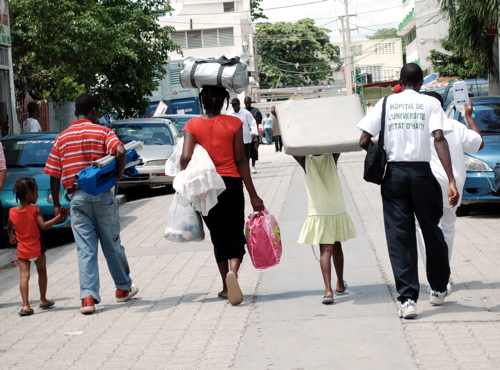 Going home
Going home
There are no sufficient toilet facilities so the family and friends of ill patients will assist their family member outside to urinate or transport a bucket or empty water bottle to and from the patient to outside. Often family members bring blood specimens to the lab, transport patients to x-ray, and retrieve blood (often scarce) from the blood bank, Winslett said.
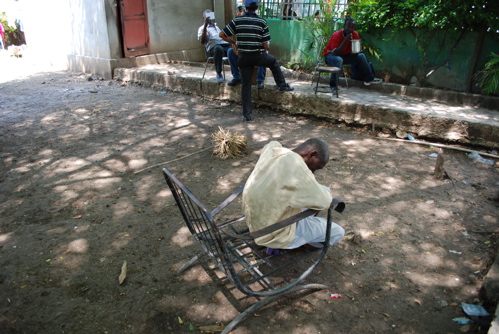
Hospital Courtyard
Yet, USAID maintains on its website:
The most effective way people can assist relief efforts is by making cash contributions to humanitarian organizations that are conducting relief operations. Information on organizations responding to the humanitarian situation in Haiti may be available at ReliefWeb and USAID. USAID encourages cash donations because they allow aid professionals to procure the exact items needed (often in the affected region); reduce the burden on scarce resources (such as transportation routes, staff time, and warehouse space)....
Draw your own conclusions about why HUEH is still struggling four months after the earthquake. Money is flowing into the coffers of international aid organizations and bypassing Haitian medical workers and institutions.
Haiti is not waving at America. Haiti has the professional expertise to help itself, if only given the opportunity and monetary support to do so. Yes, accountability is needed, but for USAID to suggest that "aid professionals" are the only entities that can accomplish this is not true. Haiti is not an abandoned infant, needing a savior. Abandoned by the international banking community, yes, but fully capable of taking care of her people if given the resources to do so.
To date, USAID is reporting that $1,059,050,150 has gone to Haiti since January 2010 through "implementing partners."
The international donor community's "implementing partners" must stop feeding on Haiti's suffering.
